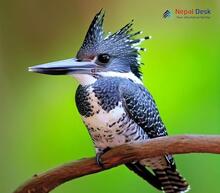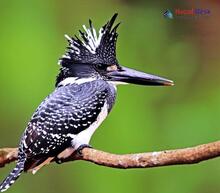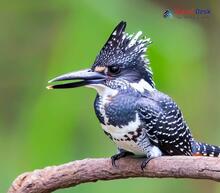Kingfishers are a diverse group of birds with captivating colors and fascinating characteristics. Among them, the Megaceryle genus is particularly noteworthy for its impressive size and striking patterns. In this article, we'll delve into the origins, taxonomy, and systematics of the Megaceryle genus, take a closer look at its evolution chain and genetic phylogeny, enumerate its various species and their distinct features, and highlight its presence in the biodiverse region of Nepal.
Origin, Taxonomy, and Systematics
The Megaceryle genus belongs to the family Alcedinidae and is commonly referred to as the "large kingfishers." First described by French zoologist Charles Lucien Bonaparte in 1850, these birds are renowned for their fishing prowess. These powerful predators are found near bodies of water throughout North America, South America, Africa, and Asia.
Evolution Chain and Genetic Phylogeny
The exact evolutionary history of the Megaceryle genus remains a topic of ongoing research. Examination of molecular data has led scientists to believe that large kingfishers are closely related to other members of Alcedinidae like Halcyon (tree kingfishers) and Ceyx (river kingfishers). The phylogenetic analysis suggests that Megaceryle has developed specific adaptations to suit their aquatic environments while retaining traits that are shared among all kingfisher species.
Species List and Characteristics
The Megaceryle genus comprises four species:
1. Megaceryle torquata (Ringed Kingfisher): The largest of the four, this North American native has a striking blue-gray plumage with a broad white collar separating its chestnut breastband from its gray-brown head.
2. Megaceryle lugubris (Crested Kingfisher): Found throughout Asia, these kingfishers are easily recognized by their large, crested heads, black plumage with white spots, and bright orange underbelly.
3. Megaceryle maxima (Giant Kingfisher): As the name suggests, the giant kingfisher is the largest among African kingfishers. Males are adorned with rufous chestnut under tail coverts, while females exhibit black and white bands across their chests.
4. Megaceryle alcyon (Belted Kingfisher): A North American staple found near lakes and rivers, males have slate blue-gray upperparts and a distinctive blue band on their chests. Females exhibit an additional chestnut belly band.
Presence in Nepal
Among more than 900 species of birds recorded in Nepal, the Crested Kingfisher (Megaceryle lugubris) holds a special place as the only member of the Megaceryle genus found within its borders. They are typically spotted close to fast-flowing rivers along the Himalayan foothills up to 1500 meters elevation during non-breeding migratory periods.
Megaceryle kingfishers display exceptional beauty and diversity within their genus. Their vibrant colors, unique features, and presence across various geographic regions make them fascinating subjects of study for ornithologists and bird enthusiasts alike. With ongoing research shedding light on their evolutionary history and genetic relationships, our appreciation for these magnificent avian predators will only continue to grow.




